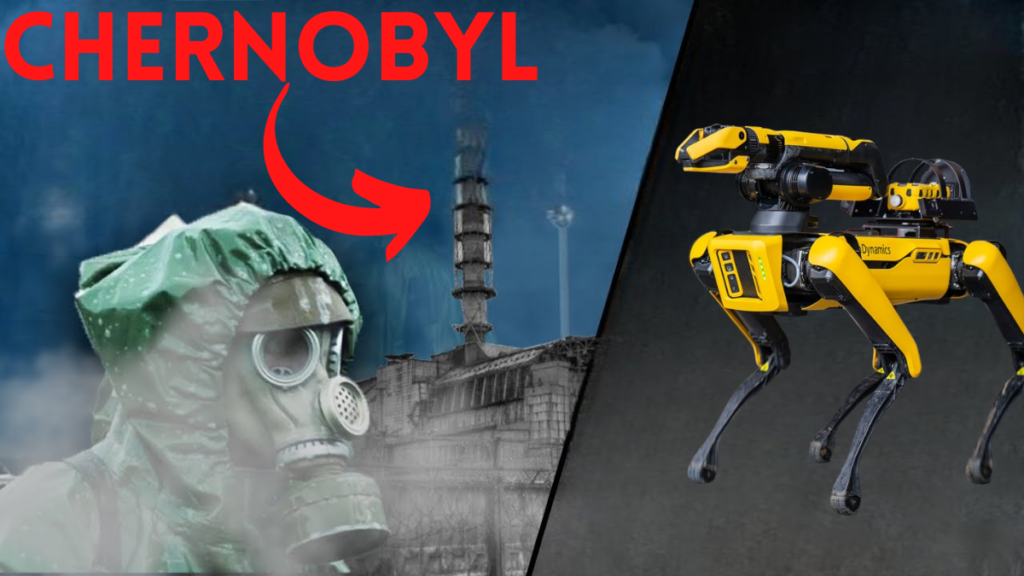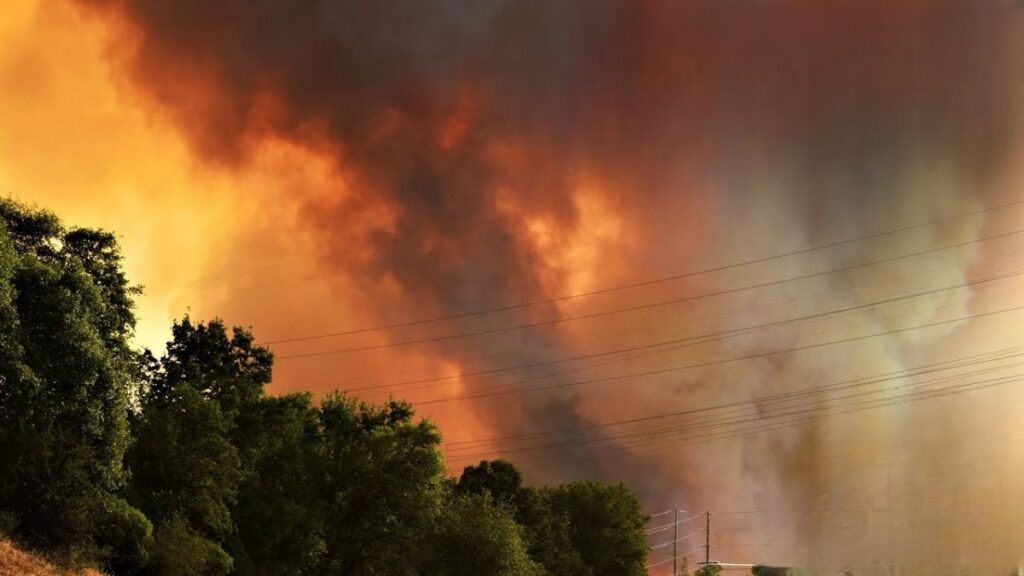
Last week, a group of engineers from the University of Bristol visited the Chernobyl Nuclear Plant to test out a four-legged robotic dog called Spot, which was developed by Boston Dynamics.
According to Ukrainian broadcaster Ukrinform, this robot is able to inspect environments on its own and navigate through hazardous locations, such as the highly radioactive Chernobyl site.
The robot’s primary objective during the visit was to survey radiation levels in the area and create a 3D map of the radiation distribution. In addition to using Spot, the team from Bristol University also utilized drones and remotely controlled sensors and scanners during the exercise.
Last year, researchers from the University of Bristol conducted the first drone-based mapping survey of the Red Forest, a wooded area near the Chernobyl power plant.
The world has never been the same since the explosion of four nuclear reactors at the Chernobyl power plant on April 26, 1986.
The catastrophe prompted an outpouring of occasions the impacts of which are as yet being felt today and to date it.
It will be nearly impossible to comprehend the effects of the Chernobyl explosion, which remains the most devastating nuclear disaster in history.
It is said that the nuclear fire lasted 10 days and produced 400 times as much radiation as the Hiroshima bomb explosion.
The nuclear power plant’s location in the town of Pripyat during World War II remains closed to the public to this day. The disaster itself is regarded as the worst in human history.
Although the Chernobyl disaster left behind some truly fascinating discoveries, estima suggests that the town could easily remain highly radioactive for thousands of years.
An abandoned carnival right is one of the most shocking things discovered in the aftermath of the global disaster.
In pripyat, a town in the northern part of Ukraine that was once a part of the Soviet Union, the Chernobyl power plant was located.
In addition to housing the power plant, the pripyat was also where the majority of Chernobyl workers lived and raised their families.
Due to the disaster, the pripyard, once home to over 50,000 people, is now essentially a ghost town and was evacuated in less than a week.
Interestingly, an abandoned amusement park is one of pripyat’s most prominent locations.
In a prominent area of the town, the park served as a public asset.
Today’s appearance is a million times more eerie than it was in 1986.
The pripyat amusement park was supposed to open on May 1, 1986, just in time for the May Day celebrations, which are also known as national workers day in some countries.
However, following the catastrophe, Soviet officials decided to open it on April 27.
Instead, to keep the locals busy and give the government more time to try to hide the nuclear disaster,
Naturally, this did not work, and less than three days after the disaster, the entire town had to be evacuated.
So the recreation area was basically unused and has stayed that way from that point onward.
In point of fact, a lot of people who visit the Chernobyl Exclusion Zone enjoy wandering around the park, expressing a morbid fascination with the park’s complete absence.
All that is left are a decaying ferris wheel, a rusted skeleton of a merry-go-round, and an abandoned bumper car ride surrounded by overgrown vines. It gives off a certain creepy, awkward feeling.
The park almost appears to be a component of a structure that contributed to the eerie setting.
What better method for representing a phantom town where large number of kids once resided and played like a creepy ferris wheel.
The modern ferris wheel, which is associated with a deserted city, is susceptible to a variety of issues and easily turns into a pile of filth, but there is something eerie about one that goes up and down only to expand and expose its passengers to radiation.
Without a touch of art, graffiti depicting missing locals would truly be a disaster.
We don’t believe that graffiti artists have always taken advantage of every opportunity they can to make a point, and this is especially true in light of the Chernobyl disaster.
despite the fact that the town of Pripyat has been effectively closed off to anyone attempting to enter by the Soviet government.
Some people have tried, and they have succeeded. Graffiti artists who say they are from Belarus and Germany broke into the Chernobyl exclusion zone and left beautiful artwork all over the area. These works show what the artists thought it was like to live in the last days of preparation.
It was also rumored that several locals in pripyat created paintings and murals throughout the city prior to being evacuated, which makes them even more haunting when you consider that the town no longer has any residents.
Probably the most striking works of spray painting craftsmanship remember a canvas for an unwanted room showing a young lady with bows in her ponytails as she goes after the light.
A boy is attempting to maneuver a toy truck into the building’s corner from a switch on another wall.
Dancing people, kids jumping, and men making funny gestures are all depicted in some paintings.
The shadows that remained on the steps and walls of buildings in Hiroshima after the US military dropped a nuclear bomb on the Japanese city during World War II appear to have served as inspiration for the silhouettes.
If their pictures are any indication, these silhouettes are definitely quite unsettling to look at. Can you imagine walking around the city in the early evening and watching as they keep looking at you super creepy, a bloody red forest? These silhouettes are extremely eerie.
Since the Chernobyl disaster more than three decades ago, enormous amounts of radiation have been released, which has resulted in the emergence of new species of wildlife, some of which are to say the least unsettling.
The plant in the vicinity of the power plant, which many people refer to as the “wormwood forest,” is especially odd.
The wormwood forest had been home to thousands of pine trees, all of which perished as soon as the radiation tore through them. If you’re still doubting the power of the radiation, there’s a good scale for you even today: the expanse of land that houses the forest could easily be taken as the most radioactive patch of land on the planet, with the area around the power plant now essentially dead. At the time, was the first to get hit with radioactive material in the fallout of the disaster.
It has taken up somewhat of a rural yellow tone.
As a result, the name “red forest” is pretty catchy.
Think about it: in addition to the trees, the radiation has a significant impact on wildlife and the forest floor.
However, it also appears that the forest’s natural biodiversity has begun to recover in the years since the disaster. Although the red forest retains its name, it is gradually becoming a permanent haven for natural life.
After additional rare species like the lynx and black grouse were reportedly discovered, reports from today have confirmed that animals have even begun to live in the forest.
There is a good chance that it will continue to grow over time because humans are unable to get close to this forest, indicating that it could be a thriving wildlife habitat.
Several tourist routes do allow members to go through some roads along the forest just to see it. The red forest is a truly fascinating occurrence when you think about it. The Chernobyl disaster has left thousands of dead over the years, and just close to the side of the incident, the pine tree forest got a moniker that could easily signify the amount of blood spilled. Prpyat’s creepy dolls and horror movies are basically a match made in heaven.
For reasons unknown dolls have a shocking dreadfulness that simply makes them ideal for blood and gore movies and scenes so it appears to be just correct that they assume a part in recounting the chernobyl story too much under ordinary conditions, dolls can show up lovely startling with their dead eyes, exhausted like appendages and stone cold steps.
When the government decided to evacuate the citizens and residents of Prpyat following the Chernobyl disaster, they told them that it would only be temporary, so most residents thought they’d be back soon. They packed light, taking only what they needed, and many children abandoned their toys for what they thought would be a short trip. The chilling effect is even more frightening when you consider the small source of these dolls radiating and rotting for years.
However much of the time these toys were left precisely where children played with them young ladies deserted their priceless little dolls any place ever they were as the departure started in schools at home and in nurseries today large numbers of those dolls are as yet unblemished where they were left in peculiar stances that their proprietors had put them in investigating the void and hanging tight for the day their proprietors would return a day that won’t ever come a considerable lot of these dolls have likewise experienced broad radiation harm showing up and look significantly really upsetting.
Imagine chucky from the movie “Children’s Play” with a bruised face and a deathly look that just sends chills down your spine.
Numerous of the dolls have been captured on camera with their radiation-damaged faces, peeking out of windows, balancing on walls, and assuming various other positions.
Although some of these dolls’ positions would have been altered to make them appear better and more threatening to the camera, overall, the sarcophagus is a pretty sad sight considering the various developments surrounding the Chernobyl power plant.
The sarcophagus, which is essentially a large dome that covers the defunct nuclear power plant and helps to trap a lot of radiation, has been perhaps the most impressive.
Said to have taken 206 days to construct, the sarcophagus was surrounded by 14 million cubic feet of concrete and over 8,000 tons of metal.
According to reports, workers were required to work on this project around the clock, putting it together in five- to seven-minute shifts because working longer shifts would have exposed them to even more radiation, which could have caused them to literally die. Nevertheless, many of these workers eventually passed away, while others became seriously ill, with the majority of them developing cancer.
Talk about making crazy sacrifices: the original sarcophagus wasn’t very efficient, but it did its best to get the job done. Twenty years later, a new one was built. To move it from Italy to Chernobyl, they needed about 18 ships and over 2,000 trucks.
As we mentioned earlier, some fungi have lost ground since the Chernobyl disaster. It was installed completely in November 2016 and now stands over the fungus that ate radiation from the failed reactor.
However, this does not mean that nature is not putting in its best effort to retaliate.
Scientists discovered some fungi in a nuclear reactor in 2002, where radiation levels were at their highest. While this discovery is remarkable in and of itself, what’s even more exciting is that scientists found that these fungi would grow even faster when exposed to higher levels of ionizing radiation. No one knows what the results of those tests will be, but we sure hope those fungi were stored properly. The world needs a lot of radiation-eating fungi to be all over the place right now.
Another staple of horror films is the “hospital of doom.” It seemed like hospitals always took the brunt of disasters, and in “Chernobyl,” the “hospital of doom” is “pripyat city hospital number 126,” a huge medical complex with about 410 beds.
Outpatient facilities, multiple small clinics, an infectious disease center, a dental clinic—you name it—were all part of this well-equipped hospital, which was designed to handle any medical problem the city’s authorities had imagined.
After the Chernobyl disaster, 237 firefighters, plant workers, and soldiers were sent here for treatment after the nuclear reactor went down.
The World Health Organization estimates that approximately 28 people died within the first three months of being brought here. Their clothing was so radioactive that it had to be taken to the basement of the hospital, where they remain today. Many of them never emerged.
Today like wherever else in pripyat emergency clinic number 126 is a fruitless no man’s land clinical and medical clinic reports expose on the clinic’s floors while its cellar is really quite possibly of the most emanated region in the whole city.
It’s easy to get distracted by everything that happened in the Chernobyl disaster that we also forget the times when the Chernobyl disaster happened decades ago. Just imagine how haunting it must have felt to be in that hospital. Soviet propaganda
The evacuation of pripyard occurred less than three days after the Chernobyl disaster, and as we mentioned earlier, the government was successful in persuading the locals that this move was only temporary because the majority of people only left with their essentials. As a result, pripyat now appears to be a meticulously preserved portion of history. Considering the things in pripyat were left exactly as they were at the time, it has been interesting to see how people lived.
You can in any case go into the city and find banners and flyers that help you to remember soviet time.
Ukraine, the whole town is loaded up with promulgation materials from schools to emergency clinics and public spots promulgation materials fly wherever you can track down representations of soviet pioneers structures to respect fighters and individuals of war and different principles that help individuals to remember that residing under the standard the soviet union was so marvelous.
It’s interesting to see how these materials played out and the effects they must have had on people back in the day if only they had known what was really going on behind the scenes. A room filled with gas masks and radiation go pretty much together. We now know the power of propaganda in the modern world.
After all, there are only so many ways that people can protect themselves from deadly contamination. When the Chernobyl disaster occurred, many people rushed to the scene to help, and when they got contaminated, the gas masks they wore had to be thrown out all over the city. One room in middle school number three, one of five secondary schools in pripyat at the time, appeared to have an excessive number of gas masks. Photographs have shown a classroom in the school filled with gas masks,
It can be interestingly terrifying to stand in the classroom and imagine the events that led to the masks all over the floor.
Anyway the covers in his homeroom were really not utilized in the chernobyl debacle rather they were supposedly away at the hour of the catastrophe and weren’t utilized by anybody at the school.
If you take a closer look at the masks, you’ll see that most of their filters are gone. It’s likely that looters took them out to get the small amount of silver inside. Who knows where all that silver might be today—maybe it’s even being worn as jewelry by someone you know right now.
Radioactive animals in the years leading up to the Chernobyl disaster, the vast land surrounding the nuclear power plant had almost no wildlife, probably because most of the animals were hunted for sport. However, when the disaster occurred and people had to leave the city, the animals found a new place to call home.
The only issue, of course, was that their new home probably wasn’t the best fit for them. Many of the animals look normal because they’ve gotten used to the radiation well over time; however, if you kill one and try to weed it, you’ll be in for a lot of pain.
Some reports say that some of the animals killed in the exclusion zone had radiation levels up to 2000 times higher than what is considered safe for human interaction.
Even today, it is still considered very dangerous to eat some of the game that was killed in the exclusion zone.
Thanks to Chernobyl’s mutated animals, pripyat isn’t known for its sweet beef. On the subject of animals, it was actually predicted that they would not return to the exclusion zone following the disaster.
However, these animals appeared to be thriving when they returned, which surprised experts and scientists.
Even though this was great, it didn’t surprise anyone that after the disaster, land, water, and even food all became contaminated with nuclear waste, which in some way affected animals in their area. Years later, both the wild animals and the domestic animals that were left behind started to show significant radiation-related symptoms.
These included a cat born with two faces, a lamb born with eight legs, a calf born with legs growing wings from his back, and even Saturdays—all of whom had congenital disabilities like multiple heads, messed-up faces, and muzzles or odd colors.
Humans and even animals are like Chernobyl’s babushkas because these animals don’t live long lives and may have health problems. It seems like this disaster has affected everyone.
Over 100,000 people were evacuated by the Soviet government after the Chernobyl accident, according to reports. Many of them were relocated close to the exclusion zone, while others decided to leave the country entirely, which was interesting. However, some residents of smaller villages weren’t particularly excited about leaving.
A few more seasoned ladies had demonstrated difficult and said that they wouldn’t leave their tribal land as a significant number of those ladies accepted they had endure a few pretty disastrous times the nazi intrusion of russia joseph stalin’s ruthless rule and substantially more thinking about that the ebb and flow dangers appeared to be radioactive materials that they hadn’t seen and were curious about they won’t move an inch.
After a few months, some people went back to their homes, while others stayed there for years.
In total, in the years following the Chernobyl disaster, a little more than a thousand people who were known as self-settlers returned to the exclusion zone.
The majority of them were in the middle stages of their lives, so even though they were aware of the dangers, they didn’t necessarily care. They continued to farm the land and raise animals despite being aware of the dangers. Over time, their bodies appeared to have adapted to the high radiation levels.
In the 2019 HBO miniseries Chernobyl, a soldier tries to force an elderly woman to leave, but she tells him straight up that she doesn’t want to. Why would he want to kill a sweet elderly woman?
Naturally, there are actual tourists who believe that having fun in the Chernobyl exclusion zone is an excellent idea for a fun getaway.
At the point when you add this to the way that the soviet government basically impeded this area of town away from individuals you’ll observe that a many individuals who are thrill seekers will need that essence of experience thus they hurried to the prohibition zone for the rush the chernobyl rejection zone has so far pulled in individuals from everywhere the world as per a few evaluations around 12 000 individuals yearly visit this spot to see the remnants and famous locales of chernobyl for themselves discuss a hot vacationer location now you may be asking is this protected, well the response is somewhat most travelers don’t exactly go to the areas that are so hazardous.
While others simply choose to view the Chernobyl detritus from a distance or from a distance that is not so close that they encounter dangerous radiation levels,
In fact, one travel company says it will provide a dosimeter so you can measure the amount of radiation as you go and a respirator so you can breathe clean air instead of the polluted air around the area, which must be quite reassuring.
Sure, it’s easy to see why going to Chernobyl might seem like a good idea. There’s a thrill in going into one of the most dangerous places on the planet, and since many of us like to try new things that might be risky, this is actually a pretty interesting way to get a thrill from Chernobyl’s stalkers.
We talked about the people who loved to tour Chernobyl. But what about the people who get in illegally and have been trying to get as close to the explosion as they can? If your jaw just dropped, imagine how crazy it was to research this. It turns out that there is a subculture of people called stalkers. They are essentially a group of Russians and Ukrainians who have a morbid fascination with the Chernobyl disaster and spend a lot of time trying to get into restricted areas of
If you decide to visit this location for a tour and come across one of the stalkers, maybe don’t shake hands with them, you can’t even imagine what they’ve been doing over there the examiner’s chair if you’re looking for something else that’s extremely spooky as part of chernobyl’s ruins considered this tourists found a gynecologist chair in the middle of the woods
Moving a gynecologist’s chair is no easy task, and considering the distance it was found away from the hospital, it must have taken a lot of effort to drag it out, considering the distance it was found. Okay, so obviously the chair did not make it outside of the hospital by itself. We are not going to give in to the urge to claim that it was something creepy by itself. However, it does beg the question of why someone would do this and as a follow-up, who the
So, who was responsible? Was it an overzealous tourist, one of the Chernobyl stalkers, or someone who lived in the town and was really interested in photography? Regardless of who was responsible for moving the chair, this raises a lot of questions.
Explore:











